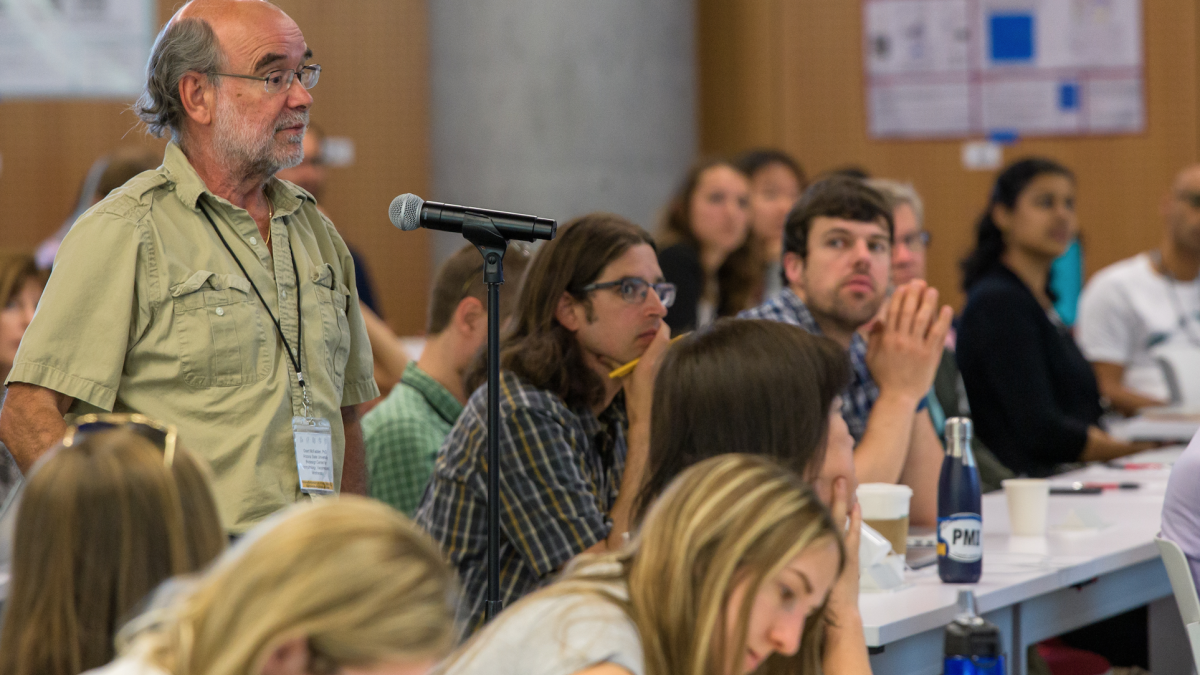AWC conference highlights work of state’s most prominent researchers

Grant McFadden, co-host of the event and the director of the Biodesign Center for Immunotherapy, Vaccines, and Virotherapy, poses a question following a presentation.
Arizona State University prides itself on an interdisciplinary, collaborative approach to solving some of the world’s most prominent problems.
Led by Joshua LaBaer, the executive director of the Biodesign Institute and center director for the Virginia G. Piper Center for Personalized Diagnostics, Arizona Wellbeing Commons (AWC) similarly emphasizes the importance of collaboration by bringing together scientists, doctors and other partners to better human health. The key to stimulating these important collaborative efforts is fostering a conversation between these professionals, especially on a regional scale.
In an effort to accomplish this, AWC hosted a symposium on June 7 with The University of Arizona College of Medicine – Phoenix at the Phoenix Biomedical Campus. The symposium invited professors, postdocs, graduate students and trainees from across the state to present on research pertaining to virology, immunology, microbiomes and infectious disease (VIMID), one of the six divisions of AWC.
“AWC brings together different sectors of research and science to interact with each other,” said Grant McFadden, co-host of the event and the director of the Biodesign Center for Immunotherapy, Vaccines and Virotherapy. “The Wellbeing Commons idea was to come up with different divisions. Part of the idea was to have meetings and interactions within the division. The other part of the idea was intertheme interactions. This is an example of a within-the-theme meeting.”
Paul Boehmer, interim associate dean for research at the UA College of Medicine in Phoenix, was the other symposium co-host.
“Ultimately, all the research we do is geared to bettering human health,” Boehmer said. “It’s a terrific initiative in getting researchers in Arizona together and for us to inspire each other.”
The symposium included three sessions, each followed by rapid-fire poster presentations. Session 1 covered immunology and the host response to infection, Session 2 covered applied microbiome research to enhance health outcomes, and Session 3 covered the tracking of immune responses and viruses. During each session, three to four researchers either from NAU, UA or ASU would present on their research projects. The symposium also hosted a poster session, during which students and researchers from across the state presented their research projects and mingled amongst their peers.
“The concept is to bring people within the state who work in the general area to interact, talk, collaborate, learn from each other’s science. That’s what today is all about,” McFadden said.
Researchers voiced that regional meetings like these are more rare than one would think, but they are a strong source of collaboration within the community.
“Institutions are good at two kinds of meetings — one is a really local one like a seminar series, and they are also really good at international meetings where people from all over the world come,” said Nels Elde, an associate professor and evolutionary geneticist at the University of Utah and keynote speaker at the symposium.
“The big hole here is a regional meeting like this where we take advantage of all the things happening in the neighborhood and then come together in ways that even though we are so close, it’s really rare that it happens. It’s a missing conversation in science — that’s why I think a meeting like this can be very powerful.”
Although these regional meetings offer up plenty of collaborative opportunities, it can be a challenge to generate interest in them. But with over 140 registrants, McFadden noted that since AWC was established two years ago, progress has been made in attracting researchers to events like these.
“They are not easy to do — the natural barrier for scientists is that they are focused on their domain, getting money, and doing their own research,” McFadden said. “Getting people to do this and follow the wider theme takes some work. But I would say so far, we can say we are making headway.”
Ultimately, the symposium aimed to foster potential collaborations among researchers, but it also served to present new perspectives to up-and-coming scientists, particularly on the cultures of different research institutes.
“We all have our own cultures, and to start to mingle those together even locally, you start to compare things in different ways,” Elde said. “For trainees, postdocs and students, it can be very powerful to have those comparison points.”
Progress is born from collaboration, and even well-established researchers can benefit from such exposure.
“What’s really great here is the intermingling of really basic science (like how infectious microbes work) all the way through how we might modulate these interactions or design therapies or interventions,” Elde added. “To have people in the room doing both things — they might seem distinct, but as we bridge those interests, that’s a really powerful opportunity.”
More Science and technology

Advanced packaging the next big thing in semiconductors — and no, we're not talking about boxes
Microchips are hot. The tiny bits of silicon are integral to 21st-century life because they power the smartphones we rely on,…

Securing the wireless spectrum
The number of devices using wireless communications networks for telephone calls, texting, data and more has grown from 336…

New interactive game educates children on heat safety
Ask A Biologist, a long-running K–12 educational outreach effort by the School of Life Sciences at Arizona State University, has…